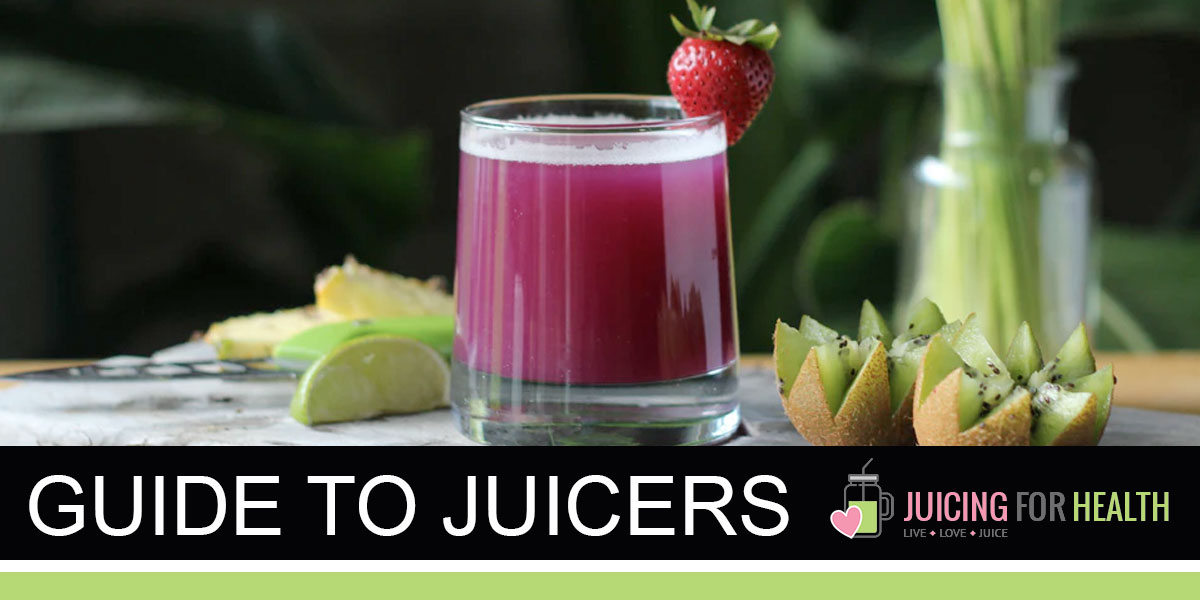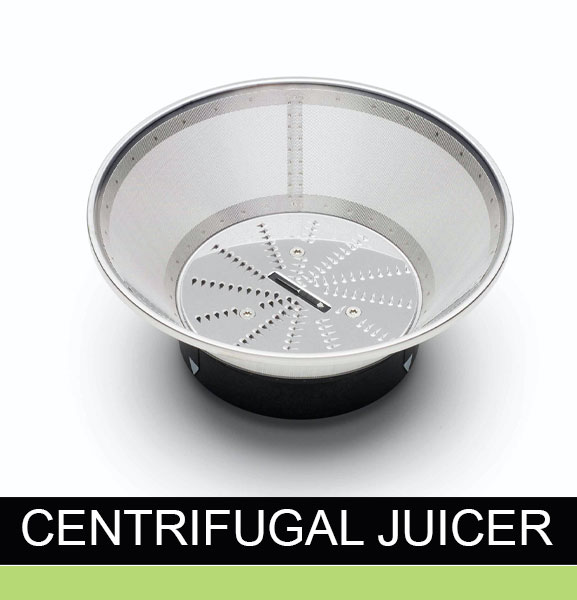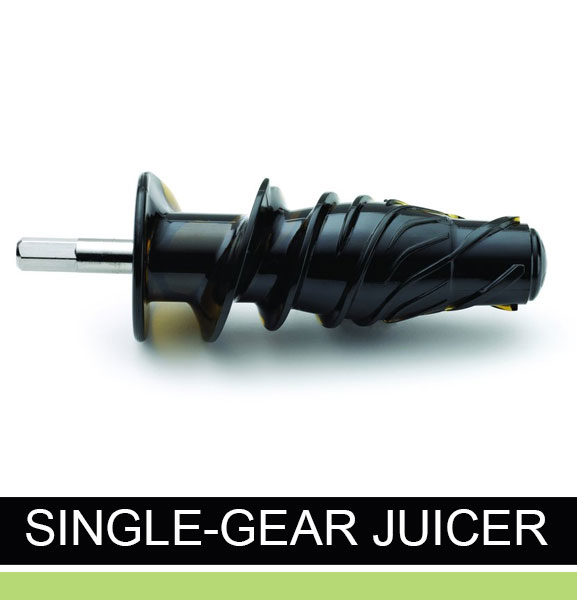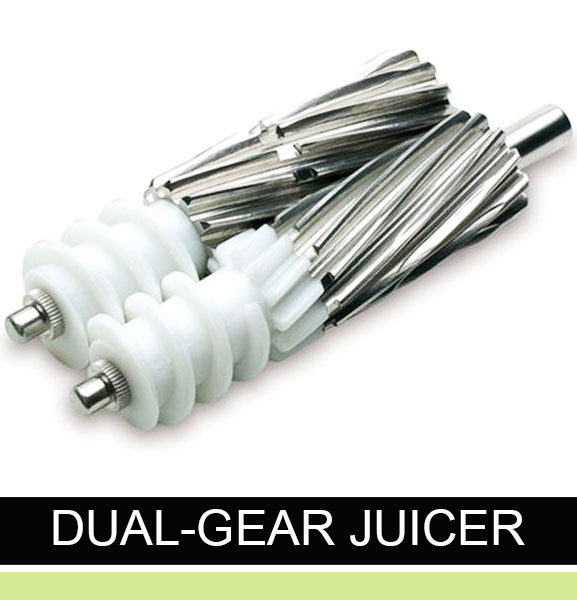The Ultimate Guide To Juicers
Last updated on
What is a Juicer?
At the core, basic level, all juicers are designed to extract the water content (the juice) of any fruit or vegetable (produce), bringing with it nutrients and several beneficial vitamins and minerals. Because all of the “good stuff” is already suspended in water, your body will readily and quickly absorb it without much effort in consumption and digestion.
Juice Extraction
The juice is extracted via several different technologies, with the most common being a centrifugal juicer, which reduces the fruit and vegetables inserted into the juicer into very small chunks via grating or slicing, and then straining the water content through a filter that catches the chunks, but allows microscopic nutrients and minerals to pass through.
As the name implies, the force acting on the solids to extract the juice is centrifugal spinning. The solids (pulp) are then flung out of the pressing area and directed towards a pulp collection area, usually a detachable container from which you can either dump the solids into compost, or use in recipes.
Juicers vs Food Processors
This is different than a food processor, which also reduces food into small chunks, in that the solids and liquids are separated, instead of remaining in the same container.
The same is true about blenders and smoothie makers, where the foods are reduced into small pieces and mixed with some form of liquid, but the solids and liquids still remain in the same container. Only a juicer intentionally and directly separates the liquids from the solids.
Cold Press Juicers
As well, there is one very special type of juicer known as a cold press. Instead of using directional and/or indirect mechanical action to extract juice from foods, a cold press quite literally crushes the food with hundreds, sometimes even thousands, of pounds of force.
As the name implies, there is no need to soften or prepare any foods such as apples, carrots, et al, for the press, as the force being exerted by the press itself is the action that will extract the juice.
Cold press juicers are usually very expensive, easily into the thousands of dollars for a unit, and are most commonly used in commercial applications. Smoothie shops or specialty beverage stores will usually have a cold press in their preparation areas.
As well, due to the forces involved, special filters are needed that are immensely more dense and fine than a common household juicer will use, as the pressures used in the press can force a solid through a regular filter.
What to Consider When Buying a Juicer
The most common question that most people new to juicing ask is: What type of juicer do I actually need? There are 5 key areas that will help make this decision much easier for the beginner juicer and may help an experienced juicer refine their search for their next purchase.
I) Juice Yield
A juice yield is, by definition, the percentage of liquid is extracted from the solids of the food used. Some foods are soft, such as cherries, strawberries, tomatoes, et al, while some are hard, such as fresh apples, carrots, beets, et al.
Where the complexity of yield enters into the discussion is regarding these hard foods, as there are several technologies involved in different types of juicers that help break down the harder foods. As a general rule of thumb, the more expensive the juicer, the better the juice yield should be, although as with all rules, there are always exceptions.
Good questions to ask, or to look for answers in reviews or suggestions, are:
- What types of foods am I using the most often in my juicing?
- Will I need to prepare the foods in any way or can I simply drop it whole into the juicer?
- Are there any interchangeable parts within the juicer that help accommodate what foods I am looking to use?
II) Service Life
The service life of a juicer is defined as the expected time between purchase and the unit encountering a failure of some type. In the industry, this is also known as a Mean Time Before Failure.
A well-cared-for juicer, that is meticulously cleaned and used according to the instructions, can last years, whereas a juicer that is used outside of its functional design can fail within months.
Rest assured, many juicers have service lives that do extend four, five, or more years. Follow the instructions on how to properly clean and maintain your juicer, and you can expect such a service life.
III) Ease of Cleaning
On the subject of cleaning, different types of juicers have different ways to clean them. Many will have a filter, usually fine stainless steel or non-oxidizing wire mesh, that will require removal and cleaning, while others will have one use only filters that need to be discarded after each use.
As well, some juicers easily come apart so that the lid, pulp catcher, and mesh can be properly washed and cleaned. Others will have parts that do come off, but through design or engineering, have parts that need to be cleaned while they are attached and mounted in the juicer.
Another important part of cleaning is how often the juicer is used. If it’s used once a week, having an easy to assemble/disassemble juicer will be more beneficial than one that is used daily or even multiple times a day, where certain parts may simply need to be rinsed with water between uses and cleaned thoroughly every few days.
IV) Ongoing Maintenance
Maintenance is what extends the life and enjoyment of using your juicer. Each manufacturer will outline in their user manual expected maintenance that the consumer must complete in helping keep their juicer in top working order.
Maintenance can include, but is not limited to: adjusting speeds of and/or distances between moving parts, per-use cleaning, proper storage of the juicer, replacing parts that are expected to wear out, and so on.
Among the most common maintenance is properly cleaning and rinsing the interior of the juicer out after use. If juices and/or pulp particles are allowed to sit without being cleaned or rinsed away, mold can form in your juicer which can not only foul the taste of your juices but may even cause health issues and breach warranty conditions.
V) Warranties & What They Cover
As with most household appliances, juicers are often covered for one year in terms of manufacturing error or obvious defective-from-factory condition.
Many companies will offer you extended warranties if you fill out an online registration or mail-in card with your juicers unique serial number or identifier. Other, higher-end juicers will often come with 3 or even 5-year warranties, and sometimes even 10 or more years, which is built into the cost of the unit that you buy.
Warranties will not cover any intentional damage or modification of the juicer, nor will they cover using the juicer for something it was not designed to do, such as attempting to use it as a blender for example.
Where to Buy a Juicer?
Now that you have an understanding of what to consider when buying a juicer, the next biggest question is: Where to buy a juicer?
Thankfully, as juicing has emerged from being something only a select few participated to a more widely accepted and understood benefit for healthy living – the range, selection, and especially availability has expanded greatly over the past decade.
Nowadays, many stores that have an appliances section will have at the very least a “cheap” juicer, a few mid-range models, and a few higher-end models. Specialty stores, online marketplaces such as Amazon, and by extension manufacturer direct via the internet, will more often than not carry mostly mid-range to high-end consumer models, to extremely high-end commercial models.
The benefit of being able to go to a store and be able to inspect the unit and ask knowledgeable staff about the juicers is that you can make a much more informed decision. As an example, with online shopping, what may look like a food chute able to handle a fully mature carrot may in fact be so narrow or small you will need to prepare the carrot to be used.
*Always try to find the dimensions of the juicer you’re looking at, and have a ruler or tape measure nearby so you can get an approximate idea of sizes.
Types of Juicers
Manual Juicers
Manual juicers are extremely common in many kitchens throughout the world. A lemon reamer, an orange press that uses a handle, or any kind of tool to extract the juice from a fruit or vegetable that uses human muscle as the power source can be called a manual juicer. For the focus of this site, however, we will stick to reamers and presses as “juicers.”
Centrifugal Juicers
A centrifugal juicer is what is considered the entry-level to juicing for health. You want to get more juice than a reamer or simple press can get you, but you also want to do it quickly and have an easy clean up afterward.
Centrifugal juicers operate by first grating or slicing the fruit or vegetable being used, then pressing the resulting pulp against a spinning filter that lets the juice pass through, but retains the pulp.
This pulp is often directed up and out of the centrifuge and into a pulp container. Due to the speed that the centrifuge spins at, juice can be extracted extremely quickly but has a lesser yield of juice than other types.
Masticating Juicers (Single Gear)
A single gear masticating juicer, which also can be called a single auger juicer in parts of the world, operates on the principle of crushing the fruit or vegetable against a solid outer wall surrounding what looks like a drill.
As the produce is crushed, it squeezes out much more juice than the centrifugal type of juicer does, however, it operates much slower and needs a little more preparation time in terms of dicing the produce to be used.
Masticating Juicers (Dual Gear/Triturating)
A dual gear masticating juicer or triturating juicer operates on the same basic principle as the single gear masticating juicer, namely crushing produce to extract the juicer. However, there are two augers that rotate against each other to effectively crush and press the produce over more surface area and extract even more juice.
These are usually the highest-end juicer that is commonly found in private homes, and some commercial business use much larger versions of these to produce their juices for sale.
Hydraulic Press Juicer
Considered the top of the range of juicers, hydraulic press juicers operate by applying hundreds of pounds of force per square inch on prepared produce. This extracts the most amount of juice, while also not heating up the pulp, giving the best “raw juice” (as it is known in the juicing community).
These types of juicers have special, single-use cloths that the pulp is wrapped in, which allows for juices to flow through, but keep the pulp from squeezing out the edges of the press itself.
These types of juicers are typically what you would find in specialty juice shops, and in commercial operations that provide mass-market juices. There are household versions, yet they are very expensive due to the nature of them needing to be built to withstand high pressures.
Which One is Right for You?
This is one of those questions that does not have an outright or simple answer. Every situation is different, and where one person can easily get by with a centrifugal juicer, another person may find a triturating juicer to be the best for their needs.
To better understand which juicer would suit you best, check out our “Choosing the Right Juicer” guide here.
Comparison: Centrifugal vs Masticating Juicers
| Function / Type of Juicer | Centrifugal | Masticating |
| Speed | Slow | Fast |
| Amount of juice from pulp | Moderate | Nearly all juice extracted |
| Cleaning | Easy | Easy to moderately complex (depends on model) |
| Cost | On average $100-$200 | Over $300 + |
Centrifugal Juicers
Strengths
- Fastest type of juicer
- Relatively inexpensive
- Most common type of household juicer, widely available in many stores
- Easy to clean
Weaknesses
- Noisiest type of juicer
- Pulp is not fully pressed of all available juices
- Juice may become aerated or start to oxidize, creating foam that sits on top of the juice
Ideal for…
- Quick juice extraction in the morning as part of making breakfast
- Those looking to make up to 2 liters of juice relatively quickly and will consume that juice within 48 hours
- On-the-go juicing, such as when needing a certain juice for some recipes
Masticating Juicers
Strengths
- Extracts nearly all juice from fruits and vegetables
- Slow speed means less possible heat and oxidation.
- Keeps more nutrients and enzymes intact compared to a centrifuge
- Very quiet
Weaknesses
- Slowest of the automated juicers
- Usually 2 to 3 times the cost of a centrifugal type juicer
- Often has a narrow feed chute to prevent blockage or jamming of the unit, meaning more time is spent preparing produce
Ideal for…
- Longer-term juice storage as more enzymes in the juice helps stability. Can keep juice 3-4 days in the fridge without much change in taste or nutritional viability
- Larger amounts of juice from the same amount of produce as used in a centrifuge. More juice is extracted with masticating juicers, which helps prevent wastage
- Those looking for the maximum nutritional impact from their juices
Recommended Juicers:
Centrifugal
Masticating
Some of the links I post on this site are affiliate links. If you go through them to make a purchase, I will earn a small commission (at no additional cost to you). However, note that I’m recommending these products because of their quality and that I have good experience using them, not because of the commission to be made.










































 JOIN OVER
JOIN OVER